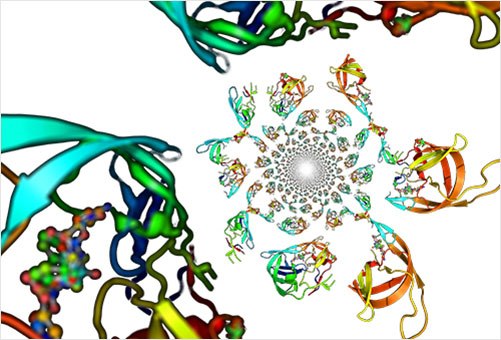Protein Mass Spectrometry

Protein mass spectrometry is widely used to analyze biological samples for biomarker discovery, proteomics research, and clinical applications. Compared to other techniques used for the large-scale characterization of proteins, mass spectrometry has become a primary tool for proteomics based on its amenability to complex analysis.
Mass spectrometry is used to quantitatively identify and characterize proteins based on their structure, post-translational modifications, and interactions.
- Protein identification typically involves chemical or enzymatic digestion of proteins into peptides, which are then analyzed by mass spectrometry and identified using computational methods or sequencing.
- Post-translational modifications can be identified through changes in amino acid residue mass. Sites of modification can be mapped using sequencing or computational methods.
- For glycan analysis and profiling, enzymatic or chemical methods are used to release glycan moieties from glycoproteins, followed by derivatization of released glycans for mass spec analysis.
- Protein interactions are determined by affinity co-purification of a specific target protein with any interacting proteins or studied more globally using size exclusion or ion exchange chromatography prior to analysis by mass spectrometry.
For quantitative proteomics, proteins or peptides can be labeled chemically with stable isotopes using tandem mass tagging (TMT) and iTRAQ or metabolically through incorporation of labeled amino acids (SILAC). Comparison of heavy and light isotope incorporation enables relative quantification by correlating mass spec peak intensities to protein abundancies. For absolute quantitation, samples can be spiked with isotopically labeled synthetic peptide or protein standards for selected reaction monitoring (SRM) analysis
In protein mass spectrometry, the masses of different proteins and peptides are determined by measuring the m/z (mass-to-charge) ratio of their gas-phase ions. Mass spectrometers first convert protein molecules into gas-phase ions using an ion source. Next, a mass analyzer separates ionized analytes based on m/z ratio. A detector then records the number of ions at each m/z value. MALDI and electrospray ionization (ESI) are commonly used to ionize peptides or proteins.
MALDI-TOF Mass Spectrometry
MALDI is an ionization method that uses a laser energy-absorbing matrix to generate ions with minimal fragmentation of protein molecules. The sample is first mixed with a suitable matrix material. Next, a pulsed laser irradiates the sample, triggering ablation and desorption of both the sample and matrix material. Analyte molecules are then ionized by protonation or deprotonation in the ablated gases prior to analysis by mass spectrometry.
Electrospray Ionization Mass Spectrometry
Electrospray ionization (ESI) produces ions using an electrospray in which a high voltage is applied to the liquid sample to create an aerosol, generating ions with minimal fragmentation of peptides and proteins. Electrospray ionization is commonly used when coupling mass spectrometry to liquid chromatography (LC-MS), as the liquid chromatography eluate can be fed directly to an electrospray for tandem processing.
Workflow


Digestion and labeling
Site-specific proteases, such as trypsin, are used to cleave proteins into small fragments to enable identification by matching experimental spectra to theoretical spectra from protein databases or comparing to run standards. For relative quantitation, cell cultures can be metabolically labeled using stable isotopes incorporated through amino acid feeding or samples can be labeled with stable isotopes using chemical methods. Spiking samples with isotopically labeled synthetic peptides permits absolute quantitation through selected reaction monitoring (SRM) analysis.

Calibration and standardization in protein mass spec
Calibration standards can serve as controls for sample analysis and be used to determine protein identity, experimental sensitivity, digestion efficiency, and aid in chromatographic separation and quantitative analysis.

Chromatographic separation
Chromatography allows separation of proteins and peptides into more manageable samples for analysis. Because multiple distinct peptides can have similar masses, HPLC is commonly used to prevent the simultaneous addition of peptides with very similar or identical masses to the mass spectrometer, increasing the overall dynamic range of measurements.

Detection and analysis
Proteins and peptides are ionized by MALDI or ESI prior to detection and analysis. A mass analyzer distinguishes ions based on their m/z values. Resulting fragmentation patterns can be used for identification, and samples can be quantitated relatively by evaluating peak intensity ratios from samples differentiated by isotopic labeling or quantitated absolutely using SRM analysis with labeled internal standards.
Visit our document search for data sheets, certificates and technical documentation.
Related Articles
- Learn more about Mass Spectrometry or MS including what it is, what it is used for and how it works.
- Protein-AQUA™™ offers robust targeted proteomics for quantitative studies across diverse research areas.
- Protein AQUA™ technique quantifies protein expression levels and phosphorylated peptides for various research applications.
- Standardize research with Universal and Dynamic Proteomics Standards, complex and well-characterized reference standards for mass spectrometry.
- Rapid trypsin digest kit yields reliable results in less than 2 hours for mass spectrometry analysis.
- See All (18)
Related Protocols
- Refinement of protein dual-labeling protocol using EnPresso® B Defined Nitrogen-free showcased by Vernalis, Ltd. for drug discovery.
- SigmaMab Antibody Drug Conjugate Mimic, is a non-toxic drug mimic utilized as a standard for mass spectrometry and high performance liquid chromatography.
- solution, 2 μg/mL in acetonitrile, analytical standard
- Explore mass spectrometry analysis of glycans for glycomic & glycoproteomic neutral & acidic glycan analysis. See a general mass spec glycan analysis procedure.
- Biomarkers play an essential role in the drug discovery and development process.
- See All (11)
Find More Articles and Protocols
How Can We Help
In case of any questions, please submit a customer support request
or talk to our customer service team:
Email custserv@sial.com
or call +1 (800) 244-1173
Additional Support
- Chromatogram Search
Use the Chromatogram Search to identify unknown compounds in your sample.
- Calculators & Apps
Web Toolbox - science research tools and resources for analytical chemistry, life science, chemical synthesis and materials science.
- Customer Support Request
Customer support including help with orders, products, accounts, and website technical issues.
- FAQ
Explore our Frequently Asked Questions for answers to commonly asked questions about our products and services.
To continue reading please sign in or create an account.
Don't Have An Account?